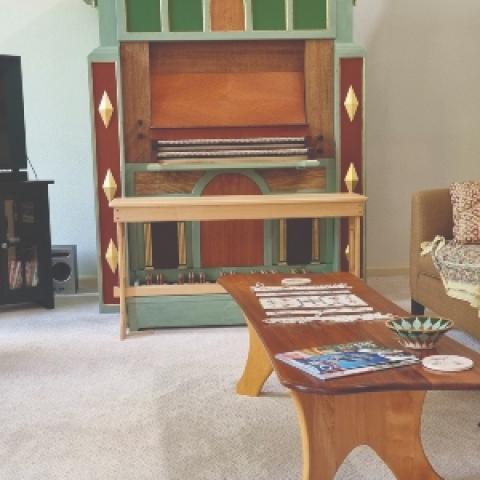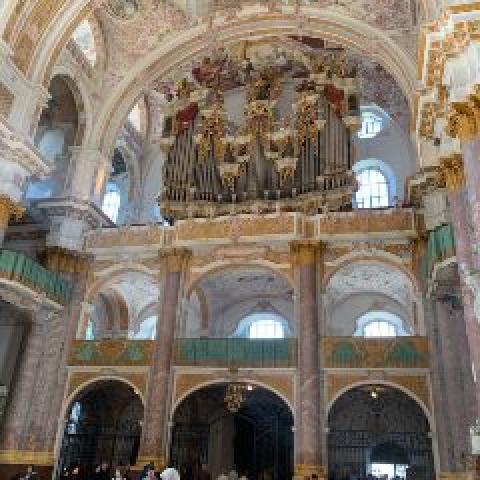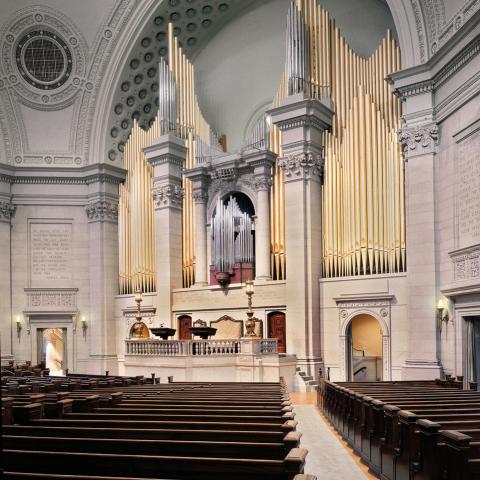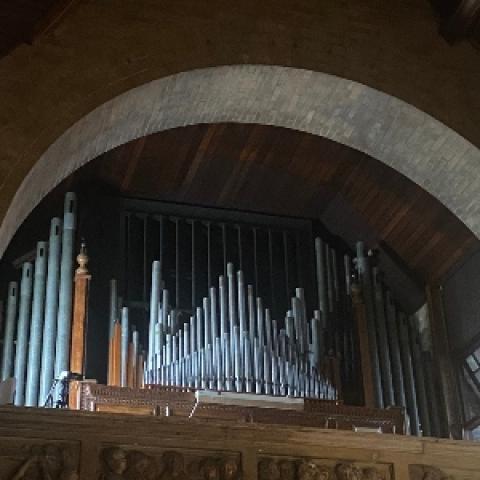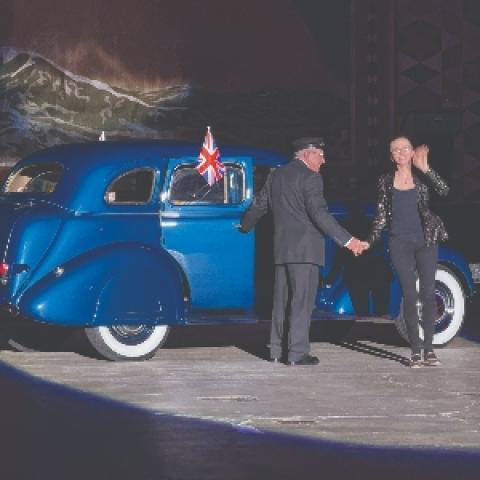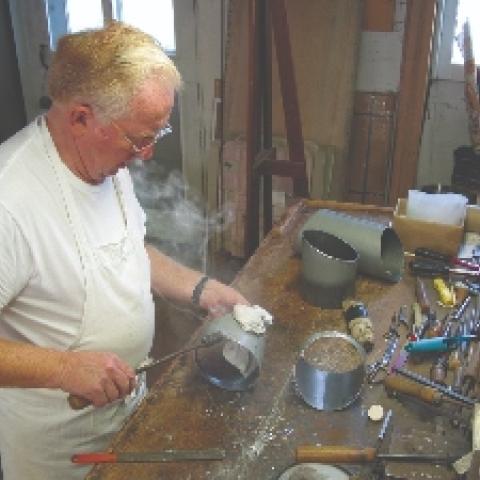
Giants among favorites
I am often asked if I have a favorite organ, a single instrument that stands out among the multitude as the best, the most expressive, the most impressive, among the hundreds I have visited, played on, or worked on. I am never able to answer clearly by citing a single instrument. There are organs that have been important in my life, but great life experiences do not necessarily focus on superb organs. I am very proud of some of the projects I have done on simple organs that I was able to expand and improve so the congregations that own them were thrilled with the result.
I have heard some of our finest musicians play thrilling programs on magnificent instruments and come away from those experiences with gratitude for a life surrounded by great musicians and great organs. I have been moved by beautiful playing on exquisite smaller instruments and amazed by the relationships of beautiful organs with the acoustics and architecture of their buildings.
I have fond memories of the organs I knew when I was a teenager first learning to play, some of which I still see regularly, and memories of rich evenings with beloved colleagues—sitting with an organ, listening to its tones, experimenting with its mechanics, marveling at its design, historical importance, heritage—and then retiring to a restaurant for a great meal. I have visited many organs nearing completion in colleagues’ workshops and then heard them as finished instruments in their “forever homes.” And as director of the Organ Clearing House, I have learned that what seemed like a forever home for an organ can vanish, leaving the organ homeless. I am especially proud of some of those when we were able to find new homes for them and see them restored for a second century of use.
There are dozens, hundreds of organs I can think of that I love and respect as great technical, musical, artistic achievements, but there is not one that I can point to as the best or as my favorite. I will cite a few standouts.
Warner Concert Hall
I was an eighteen-year-old incoming freshman at Oberlin in November 1974, my third month as a grown-up organ major, when the grand Flentrop organ was dedicated in Warner Concert Hall. I was fortunate to have grown up in Boston where I heard many wonderful new mechanical-action organs, but the Flentrop dazzled me. Painted red and blue and wearing gold negligee, it looks fantastic in the mostly whitish room. I did the hard work of practice, lessons, studio classes, and required performances including my senior recital on that organ. After a long absence I had a chance to visit it again last summer, and as you read this, I will have attended the fiftieth anniversary celebration of that organ over the weekend of November 15, reuniting with dozens of friends, classmates, and colleagues.
Basilica of Saint Martin
I visited Stefan Stürzer at Glatter-Götz Orgelbau in Pfullendorf, Germany, in September of 2019. Manuel Rosales was there working on the earliest stages of the monumental organ they are building together for Trinity Church, Wall Street, in New York City. Stefan, Manuel, Glatter-Götz’s then-new employee Felix Müller, and I had a chance to visit the Josef Gabler organ (completed in 1750) in the Basilica of Saint Martin in Weingarten, Germany. The only time we could schedule our visit was during a Mass on a Friday afternoon, but since the organ gallery is very high in the rear of the building, we were able to walk around chatting. In between leading hymns, psalms, and incidental music, the organist opened panels to show us inner workings, and he made a point of demonstrating some of the unique sounds of that remarkable organ, especially the haunting Vox Humana in the Brüstungspositiv (Rückpositiv).
There is a fascinating legend regarding that Vox Humana that had Gabler struggling to recreate the human voice exactly, and one attempt after many others fell short. The devil offered a deal: consign your soul to the devil, meet in a prescribed lonely place in the forest, and you will receive the secret for the perfect human voice, which turned out to be a piece of metal to be used to build the rank. It is not clear how Gabler got out of that pickle, but the organ was successful enough that the abbot presented him with enough wine to fill the organ’s largest pipe. (If the pipe was twenty-four inches in diameter and thirty-two feet long, that would be around seven-hundred-fifty gallons.) The name of the city and abbey gives away the source of such a plentiful supply. I remember that as a remarkable encounter with a spectacular organ in the company of admired colleagues, pretty heady stuff. That night, Felix took the photo of me that shows every month at the top of the right-hand page of this column.
Saint-Sulpice
The Cavaillé-Coll organ at Saint-Sulpice in Paris, France, is widely regarded as one of the most important and influential organs in the world. Charles-Marie Widor and Marcel Dupré filled that organ bench for a hundred years as they taught generations of students. Imagine hearing Widor’s “Toccata” from the Fifth Symphony in that church for the first time. “Oh Maître, I hope you’ll play it again.” I attended a recital there played by Gillian Weir and could do nothing but weep. Putting my fingers on the keys played by Widor and Dupré for thousands of Masses and countless hours of practice was both humbling and thrilling.
Saint James
When I was working for John Leek in Oberlin, Ohio, around 1980, we renovated a large Wicks organ in Saint James Catholic Church in Lakewood, Ohio, with three manuals and twenty-eight ranks. It was located in an ample and high loft at the rear of the church with a small two-division sanctuary organ burrowed into the reredos, an unremarkable organ except that it was in a huge, resonant church and was a product of the period when Vincent Willis III of the great eponymous British firm was working at Wicks influencing their tonal schemes.
There was a lot of unification in the organ, so there was a lot of wiring to do, much of which I did alone in a Zen state, sorting and soldering row after row of wires while listening to a gaggle of women with an occasional added man reciting the Rosary for an hour after the end of the 8:00 a.m. Mass. By the time the project was finished, that sequence of prayers was forever etched in my brain, and when I hear it today, I can smell the soldering iron.
I mention this organ because it opened my twenty-something, tracker-action, early music eyes and ears to a new understanding of Romantic music. One afternoon I was playing the ubiquitous Widor “Toccata” (he sure did play it again, and so has almost every organist since), reveling in the effect of the piece in that vast rolling acoustic. I was used to playing it on smallish tracker organs that made it sound like pelting marbles on a metal roof. So that’s what it’s supposed to sound like. Maybe there is something to this music.
“The Busch”
E. Power Biggs lived in Cambridge, Massachusetts, where he was neighbor to great thinkers like Arthur Schlesinger, John Kenneth Galbraith, and Julia Child. After working with G. Donald Harrison of Aeolian-Skinner to create an “experimental organ” in Harvard University’s Busch-Reisinger Museum (now known as Busch Hall), Biggs commissioned a three-manual, mechanical-action organ by Flentrop Orgelbouw of Zaandam, the Netherlands, which was installed in the gallery of the resonant hall in 1957. That instrument quickly became world-famous as Biggs recorded there his brilliant and influential series of LPs, E. Power Biggs: Bach Great Organ Favorites. I was deeply influenced by those recordings, and I have met countless other organists “of a certain age” whose life paths were set by those recordings. As a teenager I heard Biggs play several recitals there, memories that have stayed with me for over fifty years, and I have visited the organ several times since. It is impossible to overstate the impact of the Flentrop organ on American organ building at that time, as the renaissance that was the revival of the classic craft was gaining traction.
Trinity on Copley
I worked at Angerstein & Associates in Stoughton, Massachusetts, between 1984 and 1987 until Daniel Angerstein closed the workshop to become tonal director for M. P. Möller in Hagerstown, Maryland. Dan and I worked out that I would assume the many service clients that led to the founding of the Bishop Organ Company. Jason McKown was a legendary old organ technician in the Boston area who had worked directly and personally with Ernest Skinner and told endless stories about Mr. Skinner and many famous organists and organbuilders. He was over eighty years old and eager to retire as curator of the marvelous double organ at Trinity Church on Copley Square in Boston, where there is a four-manual instrument by the Skinner Organ Company in the rear gallery and a three-manual Aeolian-Skinner in a chancel chamber. Jason had been caring for the organ for over fifty years. The building is a heavy, dense, grand place with interior decoration by John La Farge, and the organs sound spectacular there. Brian Jones, the organist there and an old friend, introduced me to Jason, and I became curator of the organs.
Trinity Church has long been famous for noontime recitals every Friday, and I was there early every Friday morning for two hours of tuning. It was my habit to listen to Red Barber and Bob Edwards after the 7:30 a.m. headlines on National Public Radio in my car with a cup of coffee before going inside to tune.
Those Friday noon recitals meant I heard different organists play the organ every week. Some players were swallowed up by the complexity and sophistication of the big double organ with myriad controls and combinations. Others managed to tame the beast, and it sometimes seemed that the organ somehow knew when the person who slid onto the bench was going to give it a great ride. Over a period of about ten years, I heard more than 200 recitals there. Of course, there were many repeats, but hearing so many different approaches to a single organ was an important part of my learning.
A couple doozies
Once I was established at Trinity, Jason walked me the half mile up Huntington Avenue to The First Church of Christ, Scientist, known familiarly as the Mother Church, home to Aeolian-Skinner Opus 1203, built in 1952. He had been caring for the organ since it was installed, and what an organ it is with over 150 stops and 237 ranks. Jason recommended me to the church as his successor, and I had a rollicking ten years learning the mysteries of taking care of a truly massive organ.
Many of the world’s largest organs, say those with more than 200 ranks, were originally built as more modest instruments and evolved into their present glory under a string of opus numbers. One of the many remarkable things about Opus 1203 is that it was built all at once under one giant contract. Also remarkable is that it was built under the tonal direction of Lawrence Phelps, who was only thirty years old at the time. I know I thought I was quite something when I was thirty, but I am sure I could not have produced such a massive organ with such a sophisticated tonal scheme.
This amazing organ was at the center of my professional life for around ten years, and I had many important experiences and lessons there. I have written about it in these pages many times because pretty much any time I start writing about organs, it is there lurking—no, looming in the background.
I had a conversation the other day with Bryan Ashley, who has been the organist there since 2009. He revels in the organ’s majesty and subtlety and told me that it is the honor of his life to play it each week. The church has supported the organ with meticulous care since it was installed. Foley-Baker, Inc., of Tolland, Connecticut, has been working there since I left nearly thirty years ago, doing usual tuning and service calls as well as a comprehensive renovation under the direction of Phelps in the 1990s. The brilliant concert organist Stephen Tharp played a landmark recital on the Mother Church organ on June 28, 2014, the closing recital for the national convention of the American Guild of Organists. He premiered his transcription of Igor Stravinsky’s world-changing Rite of Spring in a riveting performance that I thought changed the world of organ recitals forever. His fierce rhythmic drive and dynamic, fiery registrations had the huge audience spellbound. In testament to the quality and condition of that massive organ built in 1952, Stephen told me that he practiced energetically for dozens of hours in preparation for his recital and never had to call on the technicians to correct anything.
The Mother Church organ came to mind, as it does frequently, when I was in Salt Lake City this past August for the convention of the American Institute of Organbuilders, where the famous Aeolian-Skinner organ in the Mormon Tabernacle was featured in several programs. The Tabernacle organ (Opus 1075) was built in 1945, just seven years and 128 opus numbers earlier than the Mother Church organ. It originally had 187 ranks and has been gradually expanded to today’s 206 ranks by Schoenstein & Company. It was built under the directorship of G. Donald Harrison who considered it his masterpiece, and rightly so. A quick look at the encyclopedic stoplist shows its vast variety of tone colors and combinations.
There is a fundamental difference between these two extraordinary organs. While both can be considered “American Classic” instruments, the Mother Church organ has lower wind pressures. The Positiv division is on less than two inches of wind; it is amazing that the eleven-stop pitman windchest can function on such low pressure. Along with lower wind pressures, the organ has what could be considered Baroque choruses with German nomenclature. Along with the Great, Swell, and Choir you would expect to find the Hauptwerk and Positiv with distinctly lighter tone.
Both organs are rich with multiple pairs of “celesting” stops, mutations at every pitch imaginable, and many mixtures of varying character. It is important to note that both organs are scrupulously maintained in terrific condition, reflecting the dedication of those two institutions.
Look it up.
I have been rattling from one organ to another, and I imagine some readers would be interested to see the stoplists. You are in luck. The Organ Historical Society has a broad and valuable database of organs across the United States. Visit pipeorgandatabase.com, click on “Instruments” in the upper left corner, then click on “View/Search Instruments.” That will open a form with blanks to fill in: Location (Church, Institution, etc.), City, State, Builder, Opus Number, etc. You usually only need to fill in a few blanks before the organ you are looking for pops up.
The database is a fantastic resource with photos and information about thousands of organs. The website is open on my browser whenever I am sitting at my desk, and I routinely search for information about dozens of organs. A little hint: if an organ has been rebuilt, it is likely you will find it under that company rather than the original builder. For example, you will find the Mother Church organ under Foley-Baker, not Aeolian-Skinner. Three cheers to the OHS for conceiving and continuing with that valuable project, essential to those who work with and research organs, and fascinating to all of us who are just plain interested.
If you visit the database and do not see an organ you play regularly or just know and love, go back to the original menu, click “Instruments,” and then click “Submit New Instrument Entry.” Your submission will be reviewed, someone may ask you a question or two, and then you will have contributed to a unique and valuable resource.
Next time we meet, ask me what’s my favorite organ. I’m thinking about that all the time; you may get a sassy answer.

